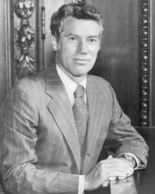Wendell R. Anderson
Wendell Anderson | |
|---|---|
 | |
| United States Senator from Minnesota | |
| In office December 30, 1976 – December 29, 1978 | |
| Appointed by | Rudy Perpich |
| Preceded by | Walter Mondale |
| Succeeded by | Rudy Boschwitz |
| 33rd Governor of Minnesota | |
| In office January 4, 1971 – December 29, 1976 | |
| Lieutenant | Rudy Perpich |
| Preceded by | Harold LeVander |
| Succeeded by | Rudy Perpich |
| Member of the Minnesota House of Representatives | |
| Member of the Minnesota Senate | |
| Personal details | |
| Born | Wendell Richard Anderson February 1, 1933 St. Paul, Minnesota |
| Political party | Democratic-Farmer-Labor Party |
| Spouse | Mary Christine McKee |
| Alma mater | University of Minnesota University of Minnesota Law School |
| Profession | politician |
| Military service | |
| Branch/service | United States Army |
| Years of service | 1956–1957 |
Wendell Richard "Wendy" Anderson (born February 1, 1933) is an American politician and was the 33rd Governor of Minnesota from January 4, 1971 to December 29, 1976. In late 1976, he resigned the governor's office in order to be named U.S. Senator to replace Walter Mondale, who had been elected Vice President of the United States. He served in the U.S. Senate from December 30, 1976 until his resignation on December 29, 1978 to give his successor seniority.[1] Anderson faced backlash from voters when he arranged to have himself appointed to the U.S. Senate seat vacated by Walter Mondale by resigning the governorship. He was not elected to the Senate.[2]
Background
Anderson was born in Saint Paul in 1933. He attended Johnson High School and went on to the University of Minnesota, where he received a B.A. in 1954. He later served in the United States Army during 1956 and 1957 and earned his law degree from the University of Minnesota Law School in 1960.
Hockey career
Anderson played defense for the University of Minnesota from 1951 to 1954, and was a member of the U.S. hockey team that won a silver medal at the 1956 Winter Olympics. Long after his on-ice career ended, he was drafted by the Minnesota Fighting Saints in the inaugural World Hockey Association draft of 1972, in what was seen as a publicity stunt. (Not to be outdone, another WHA team selected Soviet premier Alexei Kosygin.) While flattered, he chose to remain Governor.
Political career
Anderson's signature accomplishment as governor was helping to create the "Minnesota Miracle of 1971," an innovative reform in financing of Minnesota public schools and local governments that created a fairer distribution in taxation and education. For his efforts, Anderson was featured on a 1973 cover of Time Magazine.[3]
Nearly the entire DFL Party ticket was defeated in 1978, including Gov. Rudy Perpich and the candidates for both U.S. Senate seats, Anderson and Bob Short. Anderson's previous arrangement to have himself appointed to the Senate seat—and Perpich's role in that appointment—were deemed central factors in the defeats.
From 1995 to 2001, Anderson served as a director for and head of the legal committee of Turbodyne Technologies Inc. (TRBD) in Carpinteria, California. Today, he is regularly called upon to act as a commentator on Minnesota politics for local stations such as KSTP-TV.[4]
Personal
Anderson married Mary Christine McKee of Bemidji, Minnesota in 1963. They have three children: Amy, Elizabeth, and Brett. In 1975, Wendell R. Anderson was honored by two of the Swedish District lodges of the Vasa Order of America and was selected to be Swedish-American of the Year.[5]
References
- ^ Minnesota Historical Society
- ^ Nathanson, Iric (27 October 2010). "'Spendy Wendy' and the 1970 gubernatorialelection". MinnPost. Retrieved 3 October 2014.
- ^ (Time Magazine, Aug. 13, 1973 )
- ^ Minnesota Legislators Past and Present
- ^ Wendell R. Anderson (Vasa Order of America)
External links
- 1933 births
- American Lutherans
- Governors of Minnesota
- Living people
- Members of the Minnesota House of Representatives
- Minnesota State Senators
- People from Saint Paul, Minnesota
- American athlete-politicians
- United States Senators from Minnesota
- Minnesota Democrats
- Appointed United States Senators
- University of Minnesota Law School alumni
- Democratic Party United States Senators
- Olympic medalists in ice hockey
- Ice hockey players at the 1956 Winter Olympics
- Olympic silver medalists for the United States
- Olympic ice hockey players of the United States
- Sportspeople from Saint Paul, Minnesota
- Ice hockey people from Minnesota
- Minnesota Golden Gophers men's ice hockey players
- Medalists at the 1956 Winter Olympics
- Democratic Party state governors of the United States


